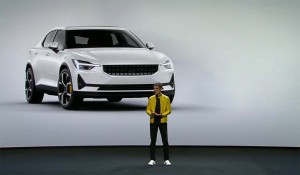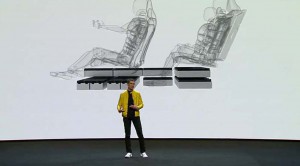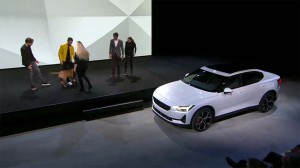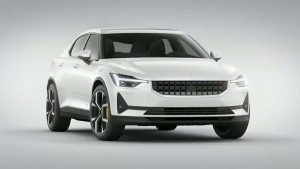In a global webcast, Volvo’s new performance subsidiary pulled the wraps off its second new model, the Polestar 2, a battery-electric vehicle set to become “the foundation of our brand,” according to Polestar CEO Thomas Ingenlath.
Set to compete with the likes of the Tesla Model 3, the new offering will initially be offered in key growth markets for electric vehicles, including North America, China and Europe. The base European model will start at 39,900 euros, or about $45,000 at current exchange rates, with the U.S. “Launch Edition” starting at $63,000 before incentives.
But Ingenlath noted that Polestar’s goal is to rethink the entire design, manufacturing and sales process, with the company putting an emphasis on all-inclusive subscriptions, rather than conventional retail sales.
“Polestar will be an intriguing addition to the new world of electric cars,” said Ingenlath, who initially joined parent Volvo as its design chief before taking on the senior executive post at Polestar. “We have invented a brand where conventional things do not fit.”
(Polestar’s first all-electric model breaks cover. Click Here for the story.)

Polestar CEO Thomas Ingenlath discusses the new Polestar 2, which is expected to go into production next year.
The Volvo brand-within-a-brand made its initial entry into the market with a high-end plug-in hybrid dubbed Polestar 1, but it is expecting that it will generate significantly stronger demand with the new all-electric model that is targeting a relatively mainstream market. That said, it will be going up against a rapidly growing mix of competitors including not only the Tesla Model 3 but the Chevrolet Bolt EV, the Hyundai Kona EV and others.
The five-door hatchback is powered by a pair of electric motors, one on each axle, producing a total of 408 horsepower and 660 pound-feet of torque. Since electric motors generate much of that torque as soon as the motors turn on, the Polestar promises aggressive launches, with 0-to-60 times promised at “less than 5 seconds.”
The battery pack itself is made up of 324 pouch-style cells storing a total of 78 kilowatt-hours of energy. Using the European test cycle, that is expected to yield 500 kilometers, or 350 miles. The U.S. EPA ratings are typically tighter but, based on what comparable products are yielding from a similar-sized battery pack, something on the order of 280 to 300 miles.
Polestar hasn’t released details on charging but the size of the pack would suggest that a drained battery would require at least 10 hours to fully charge using a Level 2 240-volt charger. The vehicle will be capable of using a 480-volt DC Level 3 charger that, depending upon the power available could give the car an 80% top-off in under an hour.
Like virtually all new pure battery-electric vehicles, the Polestar 2 uses a skateboard-like platform which contains the battery pack. The pack is surrounded by an aluminum and steel case intended to protect it in the event of an impact but Ingenlath noted that it is designed to serve as a structural element of the vehicle itself, in the process yielding a stiffer body that will enhance the car’s handling. The underfloor position of the heavy battery pack also enhances handling, he added, by lowering the fastback’s center of gravity.

Ingenlath discusses some of the technical aspects of the new Polestar 2 during the new model's debut.
The sleek design of the new Polestar emphasizes the car’s high-tech nature and Polestar 2 is fitted with features like LED adaptive driving beam headlights that remain on high at all time but which can mask out other vehicles to prevent blinding oncoming drivers.
Aerodynamics are also critical to maximize range, and Ingenlath pointed to the newly designed mirrors. The exterior tilts and swivels to reduce the size of the mirrors, lowering wind drag.
(Click Here for more on Polestar’s EV development efforts.)
The interior of the Polestar 2 puts a premium on environmentally friendly materials, according to Ingenlath. And, as with the rest of the car, there’s a definite high-tech focus, with a portrait-oriented, 11-inch touchscreen anchoring the center stack.
Acknowledging “how terribly we did fail, again and again” as an industry with voice-controlled technology, Polestar opted to partner with Google on its infotainment system. It utilizes the Google Map navigation technology, as well as the Google Home voice assistant. And a range of apps for Google can be run through the system. That said, Ingenlath said the new car also will pair with an iPhone.
The car is designed to unlock when it recognizes a driver’s smartphone, meanwhile. And once the driver sits down the Polestar 2 automatically goes into “Ready Mode,” said Ingenlath. “We put the start button into the seat. No key to turn, no start button to push.”
The battery-electric vehicle, meanwhile, will use smartphone-style over-the-air updates for its software, so it will “feel like new on a regular basis,” he added.
Plans call for the Polestar 2 to be available for order only online, though that option may not be available in the U.S. due to strict franchise laws. All told, the initial marketing plan calls for 60 dealers around the world.
Polestar will make its formal public debut at the Geneva Motor Show next month, with production set to begin in early 2020.
(Volvo aiming for half its sales to be all electric by 2025. Click Here for the latest.)
“Initial launch markets,” the automaker said in a statement, “include China, the United States, Canada, Belgium, Germany, the Netherlands, Norway, Sweden and the UK. Other markets are under consideration for future expansion.”


